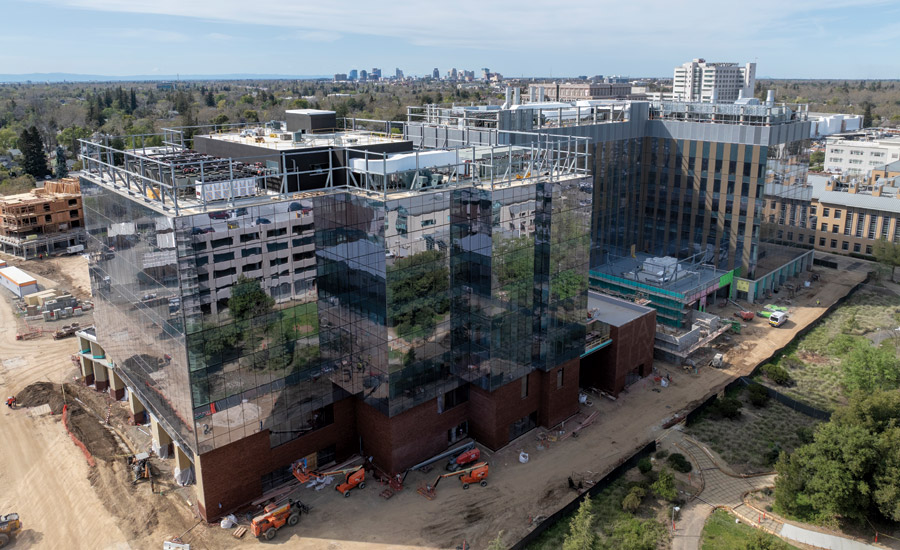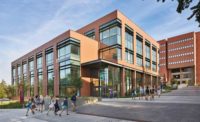A life science innovation center is taking shape on the Sacramento campus of the University of California, Davis. The $1.2-billion project combines a design that reflects the history and feel of its location through the use of locally sourced materials with cutting-edge technological capabilities that will foster groundbreaking research.
Made possible through a public-private-partnership, Aggie Square will feature state-of-the-art research laboratories, mixed-use spaces, classrooms and offices that will be occupied by UC Davis as well as by private industry and start-ups. Navigating volatile markets throughout the design phase and mitigating those impacts during construction, while at the same time maintaining a collaborative approach, has stretched the project team’s flexibility and creativity since construction began in spring 2022.

Crews place a concrete panel in June 2023 as work progressed on two primary buildings during the project’s first phase.
Photo courtesy of ZGF Architects
Phase 1, which spans 728,000 sq ft across several spaces, focused on two primary buildings: Life Sciences, Technology and Engineering East (LSTE-East, to be called 200 Aggie Square upon opening), which will house research and academics, and Lifelong Learning (LLL, or 300 Aggie Square), which will focus on public scholarship and feature spaces for start-up companies, community programming and classrooms. Combined, the two buildings have more than 590,000 sq ft of core and shell space. The scope of work also includes a six-story, 1,500-plus stall parking garage that’s now about 90% complete.
Two ancillary buildings fall under separate contracts: A mixed-use residential building with ground floor offices and 192 apartments as well as a three-story lab and office building, both of which are now under construction by a nonunion contractor.
As of late March, Phase 1 was about 70% complete, which includes the interior build-outs, says Shawn Cooper, vice president at Whiting-Turner Contracting Co., the project’s contractor. Aggie Square will eventually feature a third primary building—LSTE-West—that will flank the LSTE-East lab and share its look and size, but that contract has not yet been released.
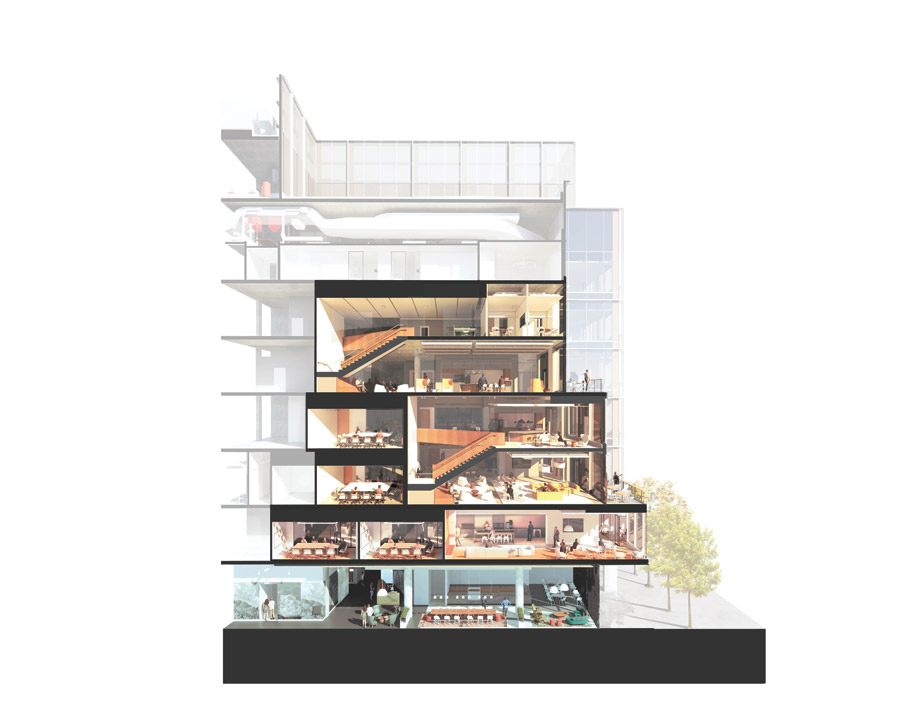
This rendering highlights the centralized collaboration spaces at the junction of the L-shaped LSTE-E building. Communicating stairs connect users between multiple floors, and a variety of lounge and meeting spaces provide areas for users to connect and share ideas.
Rendering courtesy of ZGF Architects
Built on Relationships
Moving Aggie Square forward as a P3 was a strategic choice. This partnership among UC Davis, the city of Sacramento and Wexford Science & Technology will “deliver a catalytic innovation district that blends research space, academic classrooms, start-up infrastructure, corporate innovation and community inclusion,” explains Claire Drummond, senior director and Sacramento market executive at Wexford, the project’s developer.
But it’s not a traditional P3 because it’s not strictly serving as a financing mechanism since the project also follows Wexford’s third-party developer model. This provides “a more innovative and efficient design process, faster project implementation, expertise in developing and operating innovation districts, risk mitigation and community benefits strategy,” Drummond says.
Balancing the university’s need for teaching and research space and the desire to create an innovation district that could accelerate discovery made this choice ideal.
“This was Wexford’s first project in California and on the West Coast, so it was new territory for them.”
—Vladimir Pajkic, Partner, ZGF
“You need to include incubator companies and industry partners where basic science can move through translational research to bring it to the market,” says Ted Hyman, partner at ZGF Architects, which led Aggie Square’s design. “Since UC Davis is unable to be a landlord for those companies, the P3 model allows those firms to coexist within the teaching and research space under a developer model.”
Initial plans go as far back as 2017, when Gary S. May, UC Davis chancellor, shared that he was working with Sacramento Mayor Darrell Steinberg to create a local innovation hub.
Both Whiting-Turner and ZGF came on board thanks to their respective decades-old relationships with Wexford. When Wexford entered the RFP with UC Davis, the team brought ZGF in to provide some early designs. Then Whiting-Turner joined in to provide some budgeting, and the project continued from there.
“This was Wexford's first project in California and on the West Coast, so it was new territory for them—but it was a team with long-standing relationships,” says Vladimir Pajkic, partner at ZGF.
Both the design and construction teams also had experience in Sacramento, with Whiting-Turner having previously done work for UC Davis.
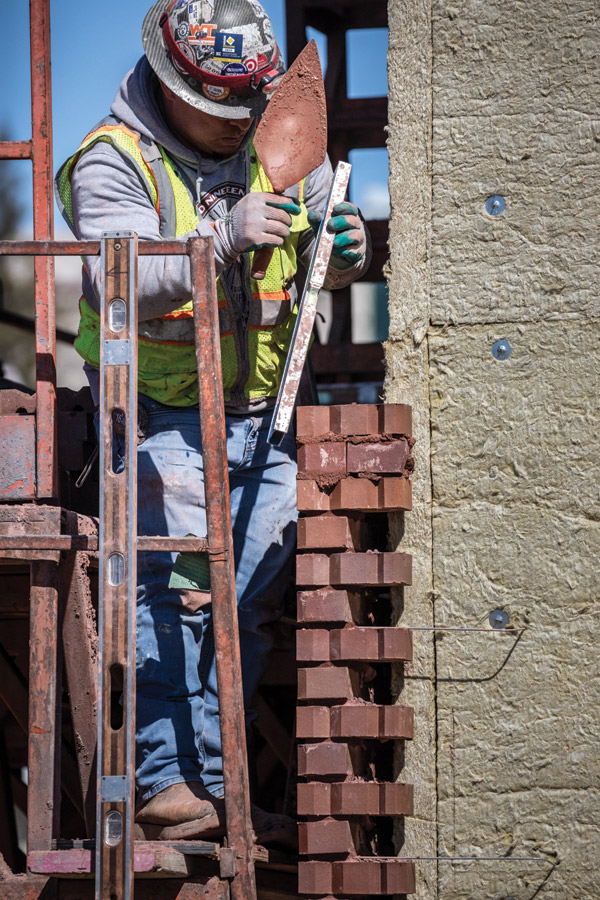
H.C. Muddox produced bricks for Aggie Square using a custom mold, local clay and a traditional process. Placing these bricks—which have textured edges—in a specific arrangement creates patterns, which the team embraced on the LLL building’s exterior.
Photo courtesy of The Whiting-Turner Contracting Co.
Materials with Purpose
When celebrating structural completion on the first two buildings that comprise Aggie Square in May 2023, the traditional beam hoisting that marks a topping-out event wasn’t possible since both are concrete structures.
More than 13,000 cu yd of concrete went into the foundation and first two floors, along with 2.7 million lb of rebar. The LLL and LSTE-East buildings’ first and second floors connect directly to one another.
LSTE-East is a traditional cast-in-place concrete structure, although the LLL building was originally envisioned as a steel structure with concrete deck. Since much of the design phase occurred during the COVID-19 pandemic, market conditions and the coinciding volatility of steel prices and lead times drove the project team toward post-tensioned concrete for the LLL structure after a series of budget and design reviews. The team made every effort to find creative ways to make the buildings unique without driving the budget up.
“That was very much an iterative process with Wexford, with ZGF, with Whiting-Turner, the structural engineer Thornton Tomasetti [all working together] to arrive at that decision. And ultimately it made financial sense,” Cooper says.
“What if the building could speak to the neighborhood in a materials sense? And that’s how we started talking about using brick.”
—Vladimir Pajkic, Partner, ZGF
But it also made design sense, as concrete offered flexibility in both aesthetics and space. Instead of 10-ft clearances, the post-tensioned concrete offered 14-ft clearances with ample daylight, plus exposed ceilings in large portions of the building, making the facility more spatially generous, Pajkic adds.
“These types of buildings can be massive and imposing, so we started off thinking about what’s in the building, this academic community-facing program,” he says. “What if the building could speak to the neighborhood in a materials sense? And that’s how we started talking about using brick, which is very much Sacramento.”
The design team drew inspiration from nearby Old Sacramento, which is flush with historic brick, taking into account its various attributes and translating those into something familiar but modern for these new buildings.
The historic connection goes deep, with H.C. Muddox producing bricks for Aggie Square using local clay in a traditional process that created similar bricks for historic buildings in the area. The Sacramento-based company has been producing building materials in the city for more than 145 years.
Although the brick uses a standard mix, the mold for Aggie Square is unique. After an initial $7,000 investment for the mold, the cost is the same as for any other type of brick.
The mold gives this brick “a kind of a jagged in and out face, and that gives texture to the wall,” Cooper explains. “It’s stacked in a way to give a texture. If you flip it or use a standard flat brick, you can create designs,” like at the east entrance on the side of the LLL building. The bricks spell out the University of California’s motto, “Fiat Lux,” or “Let There Be Light.”
“We wanted to reference the local brick and then introduce this new kind of element to it so that the building is unique and has a little character and identity,” Pajkic says.
Over the course of two winters, the construction team has managed to stay on track despite challenging weather conditions. Crews placed concrete for the foundations in November and continued concrete work throughout the winter amid record-setting rainfall.
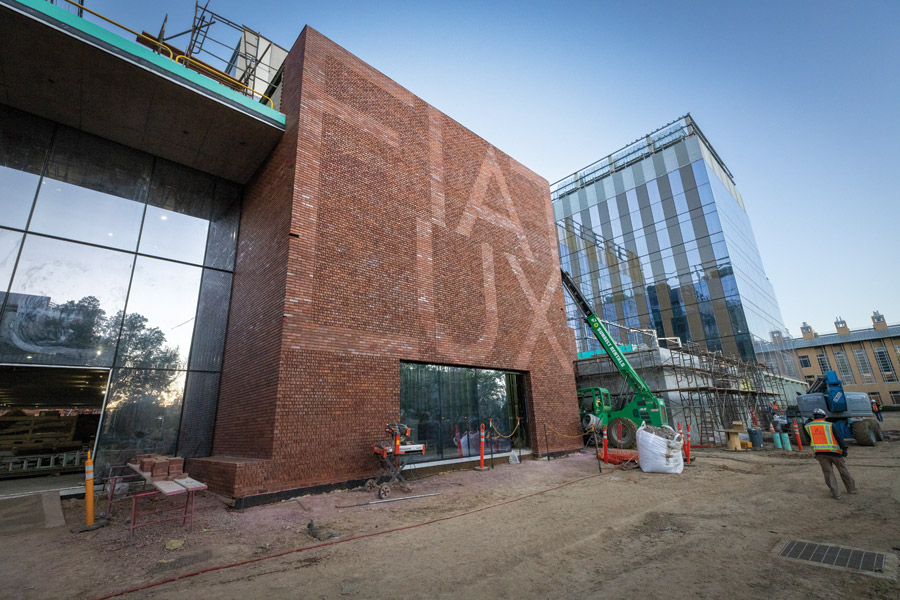
One side of the LLL building features the motto of University of California, “Fiat Lux,” or “Let There Be Light,” created by arranging the project’s specially molded bricks.
Photo courtesy of The Whiting-Turner Contracting Co.
Strategic and Nimble
The team maximized efficiency through the use of technology. Layout tools to translate the model out to the field have helped workers lay out up to 300 points a day each—“traditionally, they maybe get 20 to 30 points in a day,” Cooper says.
Prefabricating components and balancing work across the trades helped speed progress as well. For example, sequencing work allowed the concrete contractor more time to deal with the weather, while curtain wall installation progressed on a more flexible schedule since that team was based just a few miles away.
“Typically you don’t get a lot of accolades for slowing down a little bit for the good of everyone else, but in this case that really made a big difference,” Cooper says.
Ensuring that Aggie Square’s construction would positively impact the local community has meant focusing heavily on inclusive workforce development from jobs to internships and apprenticeships, Drummond says. The team has also prioritized local subcontractors and suppliers, such as H.C. Muddox and Bagatelos Architectural Glass Systems, which fabricated and installed glass curtain wall across Phase 1.
“As we were looking at designing Aggie Square, we were just finishing another building with Bagatelos,” Pajkic recalls. “We have a long-standing relationship, and so we went to the factory with the owner of Bagatelos and spent half a day walking around trying to determine what different configurations would cost. It’s not how architects usually work, but I thought it was productive.”
“Typically you don't get a lot of accolades for slowing down a little bit for the good of everyone else, but in this case that really made a big difference.”
—Shawn Cooper, Vice President, The Whiting-Turner Contracting Co.
Local subcontractors, who have been eager to take part, were also willing to remain flexible in how the work gets done, which is on brand for Sacramento, Cooper says, noting the city’s get-down-to-business mentality.
“If it means we do some things that aren’t traditional, but that gets us to the finish line, then let’s do it,” Cooper says. “That’s been a running theme through the whole project, whether it’s the electrician and mechanical subcontractor, the framer—everybody’s in it to win it.”
Such was the case when the team realized that an underground utility line running through the site could result in major delays. The team collectively responded to develop an unconventional solution—all while work continued at a steady pace. Instead of relocating the utilities, the design now cuts away a corner of the building so the utilities can remain in place. The cut-away section creates an opening into the building, allowing folks to walk right in. But to make this solution work, the entire design and construction team had to be flexible, and both sides had to analyze the change to ensure it was doable.
“That’s one of those elements that will be lost to history. People will never know why the building has the shape it has,” Cooper says. “So the building now has a jog to avoid these utilities entirely.” The team worked through four or five iterations before finalizing the fix.
“One had the corner of the building hanging over and a really crazy structural solution, which would’ve been neat to build, but not super practical,” Cooper says. “The solution is a really neat part of the project. It went from a back of house element to kind of a second front door.”
As part of a combination of strategies that will help the buildings achieve the UC standard of LEED Silver, both Phase 1 buildings are completely electric—something fairly new for the Sacramento market.

Aggie Square’s efficient MEP system relies on chilled beams and chilled sails, along with cascading air in the labs. The combination will help reduce both up-front construction costs and operating costs.
Photo courtesy of The Whiting-Turner Contracting Co.
Efficient and Impactful
A highly efficient MEP system uses chilled beams and chilled sails, along with cascading air in the labs with a goal of reducing up-front construction costs and operating costs. Meanwhile, the facade features a pattern that will minimize thermal loads based on self-shading that will occur once Phase 2 is complete. “That’s designed and hopefully will be built soon,” Pajkic says.
With 500-600 crew members on site daily, work is tracking for an on-time completion in the first quarter of 2025. These workers are primarily from Sacramento and the surrounding counties, and the project’s community workforce agreements have helped draw in talent.
That includes 72 apprentices (144% of the overall goal) who are completely new to the trades, including 22 from key neighboring zip codes alone. Overall, 62% of journey level hours and 68% of total apprentice hours have been completed by local workers, while apprentices have recorded 25% of the project’s total labor hours.
In its role as an incubator for young companies, Aggie Square will eventually contribute to the life science start-up community, which stakeholders hope will impact the city’s economy, Pajkic says. According to the university, the construction phase is expected to draw an estimated $2.6 billion in one-off economic impact.
Once completed, Aggie Square will generate an estimated 25,000 jobs and give an economic boost to the region, Drummond says.
